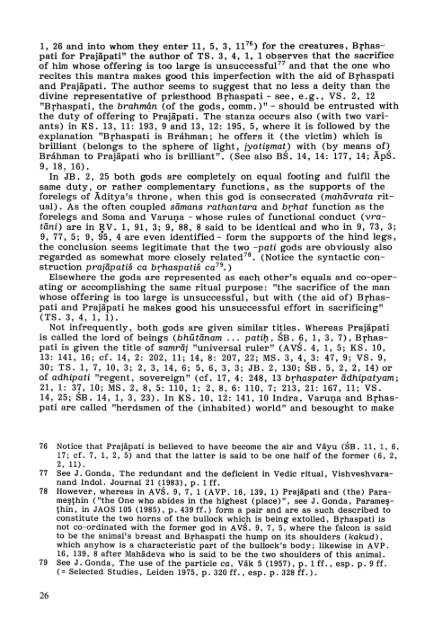Prajapati's relations with Brahman, Brhaspati and Brahma - DWC
Prajapati's relations with Brahman, Brhaspati and Brahma - DWC
Prajapati's relations with Brahman, Brhaspati and Brahma - DWC
Create successful ePaper yourself
Turn your PDF publications into a flip-book with our unique Google optimized e-Paper software.
1, 26 <strong>and</strong> into whom they enter 11, 5, 3, 11 76 ) for the creatures, Brhas-<br />
pati for Prajäpati" the author of TS. 3, 4, 1, lobserves that the sacrifice<br />
of him whose offering is too large is unsuccessful 77 <strong>and</strong> that the one who<br />
recites this mantra makes good this imperfection <strong>with</strong> the aid of <strong>Brhaspati</strong><br />
<strong>and</strong> Prajäpati. The author seems to suggest that no less a deity than the<br />
divine representative of priesthood <strong>Brhaspati</strong> - see, e. g., VS. 2, 1:2<br />
"<strong>Brhaspati</strong>, the brahm~n (of the gods, comm.)" - should be entrusted <strong>with</strong><br />
the duty of offering to Prajäpati. The stanza occurs also (<strong>with</strong> two variants)<br />
in KS. 13, 11: 193,9 <strong>and</strong> 13,12: 195,5, where it is followed by the<br />
explanation "<strong>Brhaspati</strong> is Bráhman; he offers it (the victim) which is<br />
brilliant (belongs to the sp here of light, jyoti~mat) <strong>with</strong> (by means of~<br />
Bráhman to Prajäpati who is brilliant". (See also BS. 14, 14: 177, 14; ÄpS.<br />
9, 18, 16).<br />
In JB. 2, 25 both gods are completelyon equal footing <strong>and</strong> fulfil the<br />
same duty, or rather complementary furictions, as the supports of the<br />
forelegs of Äditya's throne, when this god is consecrated (mahävrata ritual).<br />
As the often coupled sämans rathantara <strong>and</strong> brhat function as the<br />
forelegs <strong>and</strong> Soma <strong>and</strong> Varut;la - whose rules of functional conduct (vratäni)<br />
are in RV. 1, 91, 3; 9, 88, 8 said to be identical <strong>and</strong> who in 9, 73, 3;<br />
9, 77, 5; 9, 95, 4 are even identified - form the supports of the hind legs,<br />
the conclusion seems legitimate that the two -pati gods are obviously also<br />
regarded as somewhat more closely related 78 • (Notice the syntactic construction<br />
prajäpatis ca brhaspatis ca 79. )<br />
Elsewhere the gods are represented as each other's equals <strong>and</strong> co-operating<br />
or accomplishing the same ritual purpose : "the sacrifice of the man<br />
whose offering is too large is unsuccessful, but <strong>with</strong> (the aid of) <strong>Brhaspati</strong><br />
<strong>and</strong> Prajäpati he makes good his unsuccessful effort in sacrificing"<br />
(TS. 3, 4,1,1).<br />
Not infrequently, both gods are given similar titles. Whereas Prajäpati<br />
is called the lord of beings (bhütänam ... pati1;t, SB. ?, 1, 3, 7), <strong>Brhaspati</strong><br />
is given the title of samräj "universal ruler" (AVS. 4, 1, 5; KS. 10,<br />
13: 141, 16; cf. 14, 2: 202, 11; 14, 8: 207,22; MS. 3, 4, 3: 47,9; VS. 9,<br />
30; TS. 1, 7, 10, 3; 2,3,14,6; 5,6,3,3; JB. 2,130; SB. 5, 2, 2, 14) or<br />
of adhipati "regent, sovereign" (cf. 17, 4: 248, 13 brhaspater ädhipatyam;<br />
21,1: 37, 10; MS. 2, 8, 5: 110, 1; 2,8,6: 110, 7; 213,21: 167, 11; VS.<br />
14,25; SB. 14, 1, 3, 23). In KS. 10, 12: 141,10 Indra, Varuna <strong>and</strong> <strong>Brhaspati</strong><br />
are called "herdsmen of the (inhabited) world" <strong>and</strong> besoiIght to ~ake<br />
76 Notice that Prajäpati is believed to have become the air <strong>and</strong> Väyu (SB. 11, 1, 6,<br />
17; cf. 7, 1, 2, 5) <strong>and</strong> that the latter is said to be one half of the former (6, 2,<br />
2, 11).<br />
77 See J. Gonda, The redundant <strong>and</strong> the deficient in Vedic ritual, Vishveshvaran<strong>and</strong><br />
Indol. Journal 21 (1983), p. 1 ff.<br />
78 However, whereas in AVS. 9, 7, 1 (AVP. 16, 139, 1) Prajäpati <strong>and</strong> (the) Parame!?thin<br />
("the One who abides in the highest (place)", see J. Gonda, Parame!?<br />
thin, in JAOS 105 (1985), p. 439 ff.) form a pair <strong>and</strong> are as such described to<br />
constitute the two horns of the bullock whic,h is being extolled, <strong>Brhaspati</strong> is<br />
not co-ordinated <strong>with</strong> the former god in A VS. 9, 7, 5, where the falcon is said<br />
to be the animal's breast <strong>and</strong> <strong>Brhaspati</strong> the hump on its shoulders (kakud),<br />
which anyhow is a characteristic part of the bullock's body; likewise in AVP.<br />
16, 139, 8 af ter Mahädeva who is said to be the two shoulders of this animal.<br />
79 See J. Gonda, The use of the particle ca, Väk 5 (1957), p. 1 ff., esp. p. 9 ff.<br />
(= Selected Studies, Leiden 1975, p. 320 ff. , esp. p. 328 ff. ).<br />
26
















